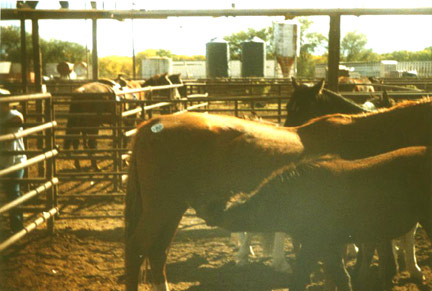Killer Buyer chapter: Lady Gold
It was Nov. 7, 1992. The cottonwoods that formed a backdrop
to the Cattleman's Livestock Auction blazed with gold. A raven
circled overhead.
My teen daughters, Valerie and Virginia began climbing the
steps to the catwalk that ran above the horse pens. Below us,
a Holstein cow stood impassively. The right side of her face
was shattered. A bloody eyeball hung out. Tiny male Holstein
calves with umbilical cords hanging pink from their bellies crowded
around her udder. Three at once were trying to suckle something
from her shrunken teats. I glanced west at the parking lot. A
truck with the logo "Your Used Cow Dealer of New Mexico"
waited nearby. They were the outfit that hauled away dead livestock.
The used cow dealer would probably get her, I thought.

Cattlemen's Livestock Auction, Belen, NM, on a pleasant
November morning.
We were there today because a friend of Marcie's wanted to
raise an orphan foal and wanted help negotiating the auction
scene. My daughters and I volunteered.
I shook off thoughts of the cow and headed south along the
catwalk. Soon we sighted two foals. A little pinto, in a pen
by herself, was lying on her side, all four feet resting on top
of the lower bar of the pen.
Marcie's friend cried out, "Is it dead? Should we go
down and help?" Suddenly the pinto untangled her legs, jumped
up and shook manure from her coat.
In the pen beside her, a tiny pinto colt lay on his side.
It is rare to see a small foal in November. Usually mares foal
no later than mid-summer. His markings were as rare as his probable
birth date. His head was dun roan with a white blaze and black
forelock. (Roan is a mixture of colored and white hairs.) The
rest of him was white except for a spot on his rump and a streak
of black in his tail. Around here, we call this pattern "medicine
hat." Native Americans say that medicine hat horses have
magical powers.
Two palomino mares and a paint stallion stood around the colt
as if fencing him in from the inhabitants of the adjoining pens.
One of the mares was so thin that we could count her ribs. After
a few minutes, the foal raised his head and shook it, then lurched
to his feet. He began nursing from one of the mares. He was so
small that his back was just about even with the underside of
her chest.
A man with a weatherbeaten face the color of old saddle leather
hobbled up the corridor outside the pen. I cupped my hands so
my voice would carry. "Whose horses are those?"
More --->>

